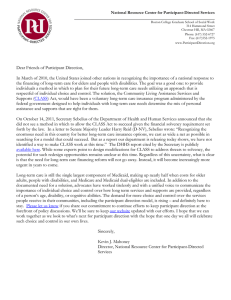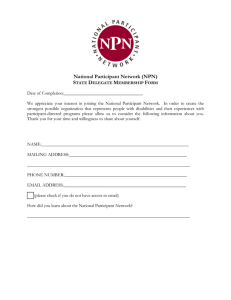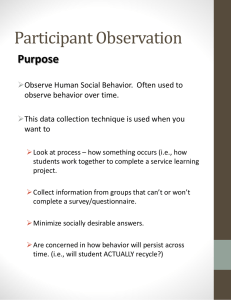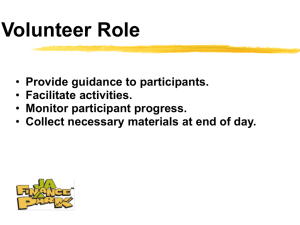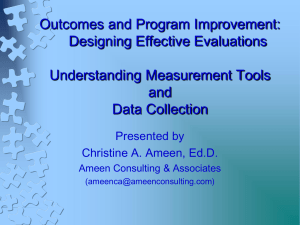Can Participant-Directed Services Work in a Managed Care World?
advertisement
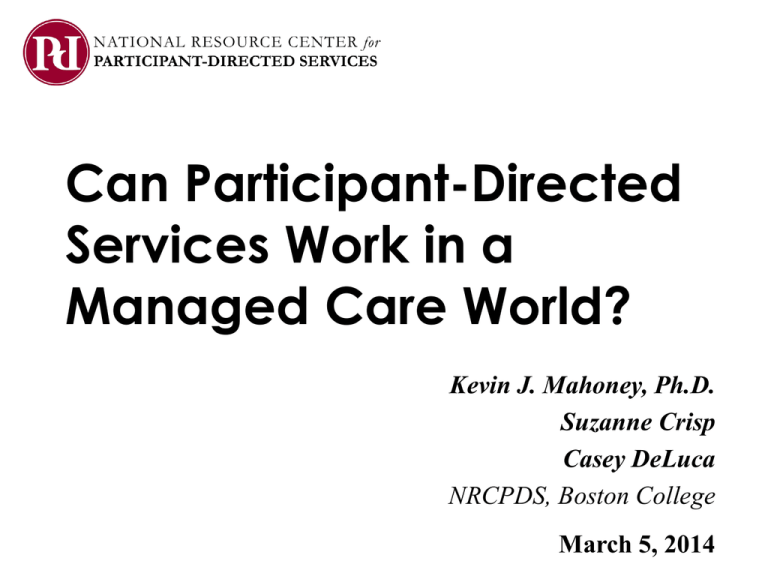
Can Participant-Directed Services Work in a Managed Care World? Kevin J. Mahoney, Ph.D. Suzanne Crisp Casey DeLuca NRCPDS, Boston College March 5, 2014 What is Participant Direction? “I feel happier and I have a better life … because I can 3 direct and manage my personal care.” “It allows you to take control of your own life again … I am 4 disabling my disability and enabling myself.” “Among a representative group of AARP members over the age of 50, 75% preferred managing services for themselves over receiving care from an agency.” -AARP Public Policy Institute Participant Direction in Managed Long-Term Services and Supports: 12 State Review 12 State Document Review: Individuals Self-Directing MLTSS WA ME ND MT VT MN OR ID NY WI SD MA MI WY PA IA NE IN NV WV CO MO KS RI CT NJ OH IL CA NH VA DE MD KY DC NC TN AZ OK NM SC AR MS TX AK AL GA Less than 2000 LA LA 2,000-5,000 FL HI Over 5,000 Data Unavailable 7 12 State Document Review: Data Highlights Participant direction authorities Populations served 7 states offer Employer Authority 5 states offer Employer and Budget Authority 11 states serve the Disabled/Elderly population (ID/DD carved out) MI serves persons with developmental & mental health disabilities MCO staff are responsible for introducing participant direction No standardization of participant-directed services or requirements across states Participant-directed contract language varies extensively by state Very few monitoring requirements No standardization in the collection of data 8 A Closer Look at 5 of the 12 States 5 State In-Depth Examination: AZ MA NM TN TX This examination revealed wide variation in: The numbers of participants enrolled in participantdirected MLTSS Training for MCO service coordinators Quality assurance, oversight, and improvement 9 Participant Direction in the Dually Eligible Demonstration: 8 State Review Overview of Dually Eligible Demonstration Project Affordable Care Act of 2010 CMS created Medicare-Medicaid Coordination Office Funding for demonstration grants to integrate Medicaid and Medicare services and their financial alignment All 8 states have completed MOUs to implement the demonstration All 8 states have adopted the managed care capitated model Washington also has a managed fee-for-service model All 8 states will have Employer Authority At least 3 states will have Budget Authority 11 8 State Document Review WA ME ND MT VT MN NH OR ID WI SD NY MI WY RI PA IA NE IN NV WV CO MO KS CT NJ OH IL CA MA VA DE MD KY NC DC TN AZ OK NM SC AR MS TX AK AL GA LA LA FL HI 12 8 State Document Review: Data Highlights Care coordination is a major component of the demonstration implementation All 8 states have chosen to require health plans to offer participant direction as an option All 8 states require health plans to operate using person-centeredness Quality indicators and data reporting on participant direction are not completely reflective of the quality of the program Half of the states only collect data on the number of care coordinators trained on participant direction but no other participant direction quality measures 13 Study Implications Study Implications Lack of participant direction standards and requirements impacts the design, operation, and evaluation of these programs. The implementation of participant direction is delegated to health plans that may or may not understand the philosophy or roles and responsibilities of participant direction. Lack of standardized service coordinator training results in participant experiences varying widely within and across states. Lack of participant-directed quality measures prevents most states from evaluating program performance and distinguishing high-quality programs from low-quality ones. 15 NRCPDS Recommendations Recommendations CMS and states should identify best practices in participant direction program design, operation, and evaluation to guide the further development of these programs. CMS, states, and health plans should identify standardized participant-directed training curricula and techniques for training health plan staff. The health plan industry should work with national consumer groups to develop participant-directed specific quality measures and a standardized way to collect program information. Similar to the National Committee on Quality Assurance (NCQA) 17 How Will We Collect Data in the Future? 18 “I sleep much better. I feel much better. You know, my biggest fear is to be stuck in the damn bed and waste my life away … I want to get out and … get back into society and do lots of things.” 19 -THANK YOUinfo@participantdirection.org www.participantdirection.org
